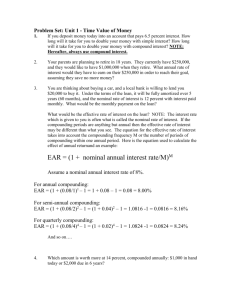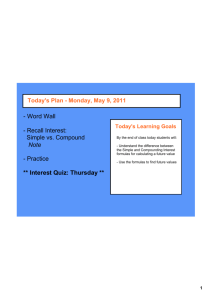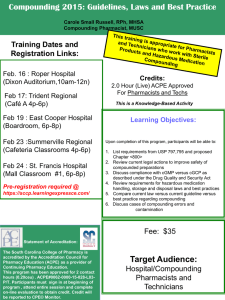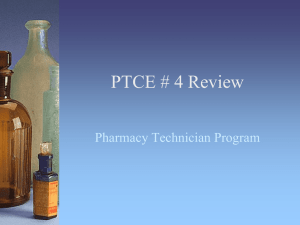Components of interest rates:
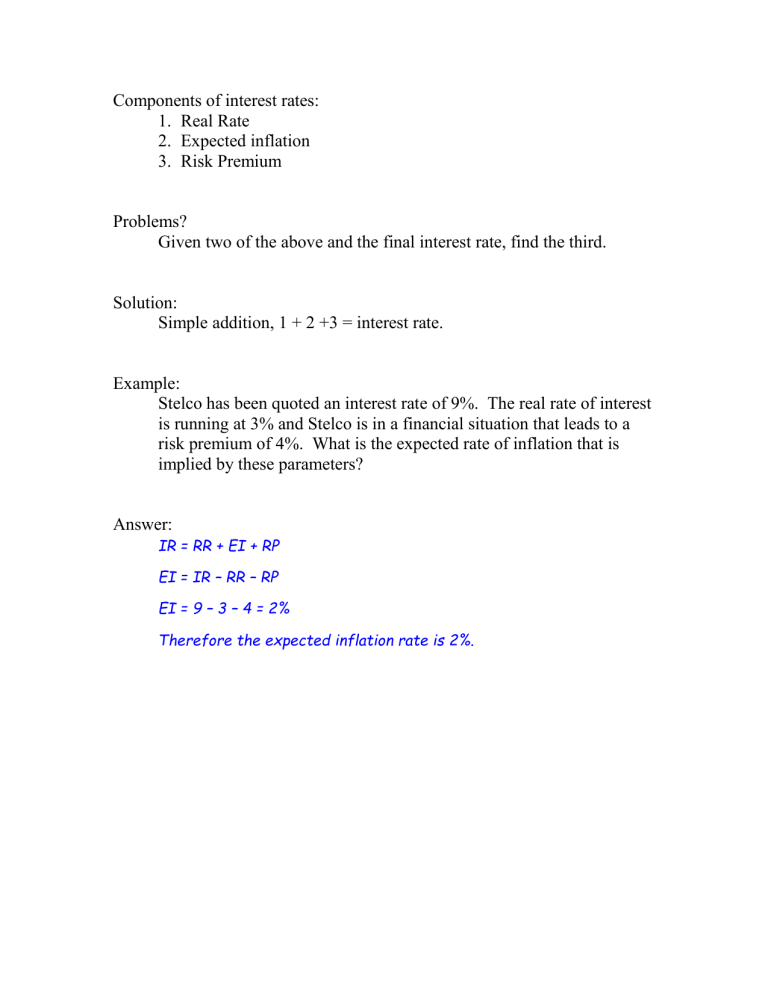
Components of interest rates:
1.
Real Rate
2.
Expected inflation
3.
Risk Premium
Problems?
Given two of the above and the final interest rate, find the third.
Solution:
Simple addition, 1 + 2 +3 = interest rate.
Example:
Stelco has been quoted an interest rate of 9%. The real rate of interest is running at 3% and Stelco is in a financial situation that leads to a risk premium of 4%. What is the expected rate of inflation that is implied by these parameters?
Answer:
IR = RR + EI + RP
EI = IR – RR – RP
EI = 9 – 3 – 4 = 2%
Therefore the expected inflation rate is 2%.
Calculation of Asset Returns:
R t
P t
P t
P
1 t
1
CF t
P t
t or, R t
= Capital Gain + Cash Flow Yield
Another way of looking at it is; the money that you have at the end of the year (capital and cash flow) less what it cost you, all over that initial cost.
Problems?
Given the initial cost, cash flows and terminal value find the rate of return. Alternatively, you could be given the rate of return and asked to find the missing value.
Example:
You bought a stock for $75. It has paid a dividend of $12. What is that stock worth today if the stock has generated a rate of return of
15% over the year?
Answer:
.15 = (P t
– 75)/75 + 12/75
P t
= 75x.15 + 75 – 12
P t
= $74.25
Capital gain = ( 74.25 – 75 ) / 75 = -1%
Cash Flow Yield = 12 / 75 = 16% or
Value at year end = 1.15x75 = 86.25
P t
= Value at year end – Cash Flow = 86.25 – 12 = $74.25
Present and Future Value:
FV = PV * (1 + k) t or
V t
= V
0
* (1 + k) t
Where k is the appropriate discount rate per period and t is the number of periods elapsed.
Note: The period for k and t must be the same.
Problems?
Given a monetary value in one time period, calculate how much that is worth in a different time period.
Example:
You have just won a credit card promotional contest. The prize is
$1,000 to be applied to your balance 9 months from today. Interest is charged at 2% per month on any outstanding balance. How much could you charge today to use up that prize? How much would you be able to charge if the effective rate of interest was 18% per year?
Answer: k=0.02 t=9 V
9
= 1,000
V t
= V
0
* (1 + k) t
1000 = V
0
* 1.195
V
0
= $836.76
Therefore you could spend $836.76 today.
With k = 18%
1000 = V
0
* 1.18
.0.75
t = 9/12 V
9
= 1,000
V
0
= 883.26
Therefore you could spend $883.26 today.
Effective Interest Rates:
If we have a stated interest rate with compounding more than once per period we must convert that before we can use it.
Generally this takes the form of k n
( 1
k n s ) n
1
Problems?
Given a stated rate of interest with more frequent compounding, find the effective interest rate per period.
Example: a) Is a loan with a 14% annual interest with monthly compounding cheaper than a loan with a 14.75% interest rate with annual compounding? b) How does it compare to a loan with a 14.5% with semi-annual compounding?
Answer:
To compare the rates we need to express them in a single, consistent format. In this case, effective annual rate is the most appropriate.
14.75% with annual compounding
14% with monthly comp. = ( 1 + .14/12 ) 12 -1
14.75%
14.93%
14.5% with S/A comp. = ( 1 + .145/2 ) 2 -1
15.03%
Therefore the 14% stated rate loan is not cheaper than the 14.75% stated rate loan, although it is cheaper than the 14.5% loan.
Continuous Compounding:
As the compounding periods become more frequent, the effective rate of interest increases. The increase is most notable in the lower ranges and eventually we approach a limit. For example at 12% stated interest rate we have
Compounding Period Effective rate
Annual
Semi-annual
12.000%
12.360%
Quarterly
Monthly
Daily
12.551%
12.683%
12.747%
Hourly
Per Second
12.750%
12.74968514%
Continuous 12.74968516%
As you can see, the difference between per second and continuous compounding doesn’t show up until the eighth decimal place.
The formula to convert a continuous compound rate to an effective rate is:
Effective rate = e k c
–1
Present value is similarly altered to be:
V t
= V
0
* e k c t
Problems?
Either present value or effective interest rate problems.
Continuous Compounding (continued):
Example:
You have been quoted a loan rate of 12% with continuous compounding. a) If you take out a $600 loan for 2 years and 10 months, how much will you owe the bank at the end of that time? b) What is the effective annual rate of interest on this loan? c) What is the effective monthly rate of interest on this loan?
Answer: a) k c = 0.12 t = 34/12
V t
= 600 * e 0.12*(34/12)
V t
= 842.97
Therefore you would owe the bank $842.97 after 34 months. b) Effective rate = e k c
–1 = 12.75% c) Effective rate = e k c
(1/12) –1 = 1.00502%

